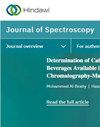基于光谱扫描的古土壤微观结构与膨胀特性实验研究
IF 2.1
4区 化学
Q4 BIOCHEMICAL RESEARCH METHODS
引用次数: 3
摘要
为探讨古土壤的微观结构及其膨胀特征,对银西高速铁路枣胜3号隧道古土壤进行了研究。利用x射线衍射(XRD)、能量色散x射线能谱(EDX)、核磁共振(NMR)和扫描电镜(SEM)技术,从矿物组成、地层元素、孔隙结构和颗粒形态等方面分析了古土壤的微观结构。试验了5组不同含水率的原状和重塑土的卸载膨胀率和加载膨胀率。结果表明:古土壤矿物成分主要为石英、钾长石、方解石和赤铁矿,其中石英含量最高,占总含量的45.4%;古土壤粘土矿物组成中蒙脱石含量最高,为12.3%。古土壤元素组成以Al、Si、Ca、Fe为主,形成石英、蒙脱石等膨胀性矿物成分,为古土壤的膨胀性创造了内在条件。原状古土壤和重塑古土壤的T2分布曲线由3个峰组成。古土壤孔隙分布以中孔为主,大孔次之,小孔和超大孔含量极少。在颗粒接触方面,原状土主要以“面-面”和“面-边”接触形式存在,重塑土主要以“点-面”和“点-点”接触形式存在。重塑土的卸载膨胀率约为原状土的两倍。两种土的加载膨胀率随含水率的增加而减小。本文章由计算机程序翻译,如有差异,请以英文原文为准。
Experimental Study on the Microstructure and Expansion Characteristics of Paleosol Based on Spectral Scanning
To investigate the microstructure of paleosol and its expansion characteristics, the paleosol of the Zaosheng #3 tunnel of the Yinxi high-speed railway was studied. Based on X-ray diffraction (XRD), energy-dispersive X-ray spectroscopy (EDX), nuclear magnetic resonance (NMR), and scanning electron microscopy techniques (SEM), the microstructure of the paleosol was analyzed in terms of the mineral composition, formation elements, pore structure, and particle morphology. Five groups of undisturbed and remolded soils with different moisture contents were tested for the unloaded expansion rate and loaded expansion rate. The results show that the mineral components of the paleosol are mainly quartz, potash feldspar, calcite, and hematite, with the highest-content-component quartz accounting for 45.4% of the total content; the clay mineral composition of the paleosol has the highest content of montmorillonite at 12.3%. The elemental composition of the paleosol is dominated by Al, Si, Ca, and Fe, which form expansive mineral components such as quartz and montmorillonite, creating inherent conditions for expansibility of the paleosol. The T2 distribution curves of the undisturbed and remolded paleosol are composed of three peaks. The pore distribution of paleosol mainly includes medium pores, followed by large pores, and the contents of small pores and superlarge pores are very small. In terms of particle contact, the undisturbed soil is mostly in the form of “surface-surface” and “surface-edge” contact, and the remolded soil is mainly in the form of “point-surface” and “point-point” contact. The unloaded expansion rate of remolded soil is approximately twice that of undisturbed soil. The rate of loaded expansion of both soils decreases with increasing moisture content.
求助全文
通过发布文献求助,成功后即可免费获取论文全文。
去求助
来源期刊

Journal of Spectroscopy
BIOCHEMICAL RESEARCH METHODS-SPECTROSCOPY
CiteScore
3.00
自引率
0.00%
发文量
37
审稿时长
15 weeks
期刊介绍:
Journal of Spectroscopy (formerly titled Spectroscopy: An International Journal) is a peer-reviewed, open access journal that publishes original research articles as well as review articles in all areas of spectroscopy.
 求助内容:
求助内容: 应助结果提醒方式:
应助结果提醒方式:


